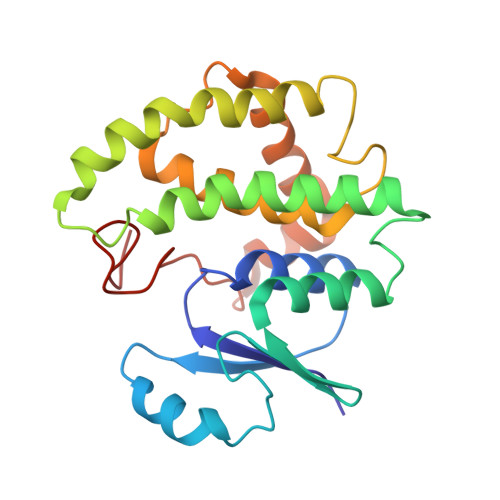Characterization of the electrophile binding site and substrate binding mode of the 26-kDa glutathione S-transferase from Schistosoma japonicum
Cardoso, R.M.F., Daniels, D.S., Bruns, C.M., Tainer, J.A.(2003) Proteins 51: 137-146
- PubMed: 12596270
- DOI: https://doi.org/10.1002/prot.10345
- Primary Citation of Related Structures:
1M99, 1M9A, 1M9B - PubMed Abstract:
The 26-kDa glutathione S-transferase from Schistosoma japonicum (Sj26GST), a helminth worm that causes schistosomiasis, catalyzes the conjugation of glutathione with toxic secondary products of membrane lipid peroxidation. Crystal structures of Sj26GST in complex with glutathione sulfonate (Sj26GSTSLF), S-hexyl glutathione (Sj26GSTHEX), and S-2-iodobenzyl glutathione (Sj26GSTIBZ) allow characterization of the electrophile binding site (H site) of Sj26GST. The S-hexyl and S-2-iodobenzyl moieties of these product analogs bind in a pocket defined by side-chains from the beta1-alpha1 loop (Tyr7, Trp8, Ile10, Gly12, Leu13), helix alpha4 (Arg103, Tyr104, Ser107, Tyr111), and the C-terminal coil (Gln204, Gly205, Trp206, Gln207). Changes in the Ser107 and Gln204 dihedral angles make the H site more hydrophobic in the Sj26GSTHEX complex relative to the ligand-free structure. These structures, together with docking studies, indicate a possible binding mode of Sj26GST to its physiologic substrates 4-hydroxynon-2-enal (4HNE), trans-non-2-enal (NE), and ethacrynic acid (EA). In this binding mode, hydrogen bonds of Tyr111 and Gln207 to the carbonyl oxygen atoms of 4HNE, NE, and EA could orient the substrates and enhance their electrophilicity to promote conjugation with glutathione.
Organizational Affiliation:
Skaggs Institute for Chemical Biology, The Scripps Research Institute, La Jolla, CA 92037, USA.















